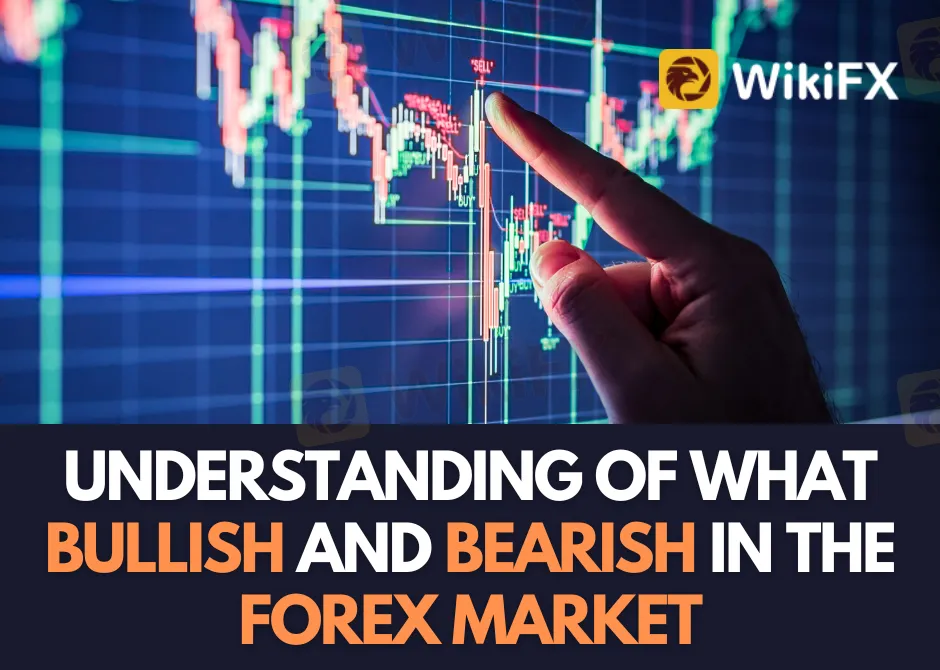简体中文
繁體中文
English
Pусский
日本語
ภาษาไทย
Tiếng Việt
Bahasa Indonesia
Español
हिन्दी
Filippiiniläinen
Français
Deutsch
Português
Türkçe
한국어
العربية
Understanding Of What Bullish And Bearish In the Forex Market
Abstract:Bulls and bears are words often used in financial markets to characterize market price fluctuations and overall market sentiment. This terminology first arose on stock exchanges but swiftly spread to most financial markets, including Forex

One of the most important advantages of forex trading is the potential it provides traders in both bull and down markets. Bull and bear markets are crucial to monitor because they help predict current market movements. In this essay, we will define bear and bull markets and examine how to distinguish between the two market scenarios.
What Is the Difference Between a Bull and a Bear Market?
Bear and bull markets are words used to describe the basic trend of markets. Simply explained, a bear market is one in which prices are falling, while a bull market is one in which prices are increasing.
In a bull market, prices increase, and investors are bullish because they expect prices to climb further as a result of the bullish market, and they anticipate selling high in the future. A bull trader initiates long positions, boosting demand and driving up the price of a trading asset.
In a bear market, prices decrease, and investors become pessimistic because they expect prices to fall more as a result of the bearish market, and they anticipate purchasing cheaply in the future. Bears sell their assets in order to purchase them at a lower price in the future.
1. Investors are hopeful in a bull market.
2. The economy is growing.
3. Positive asset class returns
4. Increased market confidence
5. Beneficial to the economy
1. Investors are gloomy during a down market.
2. The economy is shrinking.
3. Negative asset class returns
4. Lack of market confidence
5. Negative for the economy
What Is the Difference Between a Bull and a Bear Market?
1. The economic and commercial circumstances described by them
The primary distinction is that bull markets depict conditions in which asset values rise, while bear markets describe situations in which asset prices fall. In other words, a bullish condition suggests good market momentum, whilst a bearish state shows negative market momentum.
2. Market influencing factors
A healthy economy with high GDP, low unemployment, inflation under control, good market mood, active purchasing, and confidence that economic development is sustainable are all factors that contribute to a bull market.
Factors contributing to a bear market include the country's economy displaying symptoms of weakness with low GDP, high unemployment, rising inflation, negative market mood, aggressive selling, and a loss of trust in the economy and stock prices.
3. Investor behavior in both scenarios
During bull markets, investors are more confident in their profits and take a more relaxed attitude. They are more engaged and ready to invest in higher-risk assets. This is because the economic conditions are good, and lost capital may be recovered more quickly.
However, during bad markets, investors are less confident in profit prospects and tend to be less active. One of the primary causes for this is heightened market volatility and unpredictability.
How to Spot a Bullish or Bearish Market
As a trader, you must assess whether the market is in a bear or bull market when it occurs. Aside from the drop or increase in asset prices, there are a number of additional signs that may help you determine if the market is in a bull or bear market.
1. Keep up with the newest financial news.
The news and journals are useful sources for understanding market and trading behavior. Many interviews with traders and experts appear in these publications. You may also read numerous financial periodicals in addition to this. Reading the news on a daily basis will not assist; after reading, you must connect the dots in order to make a lucrative choice. There are other newsletters that give information on the trading emotions of market participants.
2. Make use of technical analysis tools
When markets are shifting from Bulls to Bears, forex traders may use a variety of technical analysis methods to evaluate market emotion and predict currency action.
Price charts and the Moving Average are the two most often used technical analysis techniques for detecting Bull and Bear markets (MA)
Some traders employ quantitative and statistical information, as well as price activity, while others compare negative and positive advice from various newsletters. These instruments' absolute data change over time might indicate to traders where the market will go in the future.
3. Relative Strength Index and Oscillators
The oscillator is one of the best forms of technical indicators for measuring bearish and bullish momentum indirectly. It contains all of the information needed to comprehend how traders feel about the financial market.
The Relative Strength Index, or RSI, is another technical indicator. It compares the number of assets sold to the number of assets purchased. The goal is to assess whether capital is moving out of or into an asset. It also allows traders to learn how investors feel about the market without having to question each trader individually.
Conclusion
Bull and bear markets are crucial to monitor because they help predict current market movements. Being aware of market patterns may help you make better judgments about risk management and develop a better knowledge of when to enter and exit transactions.
To summarize, market players' attitude is heavily influenced by exchange rate dynamics. When a negative trend is detected, traders begin aggressively selling, and prices decrease. When the bullish trend turns negative, traders begin buying in order to resell at a higher price.
Stay tuned for more Forex Educational articles
Download the WikiFX App from the App Store or Google Play Store to stay updated on the latest news.

Disclaimer:
The views in this article only represent the author's personal views, and do not constitute investment advice on this platform. This platform does not guarantee the accuracy, completeness and timeliness of the information in the article, and will not be liable for any loss caused by the use of or reliance on the information in the article.
Read more

Close Up With WikiFX —— Take A Close Look At Amillex
With the rapid growth of global multi-asset investment markets, the differences among regional forex markets have become increasingly significant. As a forex broker information service platform operating in more than 180 countries and regions, WikiFX is dedicated to helping investors in every market identify reliable brokers. Therefore, we have launched an exclusive interview series —— "Close Up With WikiFX", offering in-depth conversations with local brokers. This series aims to dive deep into frontline markets and provide first-hand information, helping investors gain a clearer and more comprehensive understanding of quality brokers.

Seacrest Markets Exposed: Are You Facing Payout Denials and Spread Issues with This Prop Firm?
Seacrest Markets has garnered wrath from traders owing to a variety of reasons, including payout denials for traders winning trading challenges, high slippage causing losses, the lack of response from the customer support official to address withdrawal issues, and more. Irritated by these trading inefficiencies, a lot of traders have given a negative review of Seacrest Markets prop firm. In this article, we have shared some of them. Take a look!

GKFX Review: Are Traders Facing Slippage and Account Freeze Issues?
Witnessing capital losses despite tall investment return assurances by GKFX officials? Do these officials sound too difficult for you to judge, whether they offer real or fake advice? Do you encounter slippage issues causing a profit reduction on the GKFX login? Is account freezing usual at GKFX? Does the United Kingdom-based forex broker prevent you from accessing withdrawals? You are not alone! In this GKFX review guide, we have shared the complaints. Take a look!

Is Seaprimecapitals Regulated? A Complete Look at Its Safety and How It Works
The straightforward answer to this important question is no. Seaprimecapitals works as a broker without proper regulation. This fact is the most important thing any trader needs to know, because it creates serious risks for your capital and how safely the company operates. While this broker offers some good features, like the popular MetaTrader 5 platform and a low starting deposit, these benefits cannot make up for the major risks that come from having no real financial supervision. This article will give you a detailed, fact-based look at Seaprimecapitals regulation, what the company claims to do, the services it provides, and the clear differences between official information and user reviews. Our purpose is to give you the information you need to make a smart decision about the risks and benefits of working with this company.
WikiFX Broker
Latest News
Simulated Trading Competition Experience Sharing
WinproFx Regulation: A Complete Guide to Its Licensing and Safety for Traders
Interactive Brokers Expands Access to Taipei Exchange
Axi Review: A Data-Driven Analysis for Experienced Traders
INZO Regulation and Risk Assessment: A Data-Driven Analysis for Traders
Cleveland Fed's Hammack supports keeping rates around current 'barely restrictive' level
Delayed September report shows U.S. added 119,000 jobs, more than expected; unemployment rate at 4.4%
The CMIA Capital Partners Scam That Cost a Remisier Almost Half a Million
eToro Cash ISA Launch Shakes UK Savings Market
Is Seaprimecapitals Regulated? A Complete Look at Its Safety and How It Works
Currency Calculator



